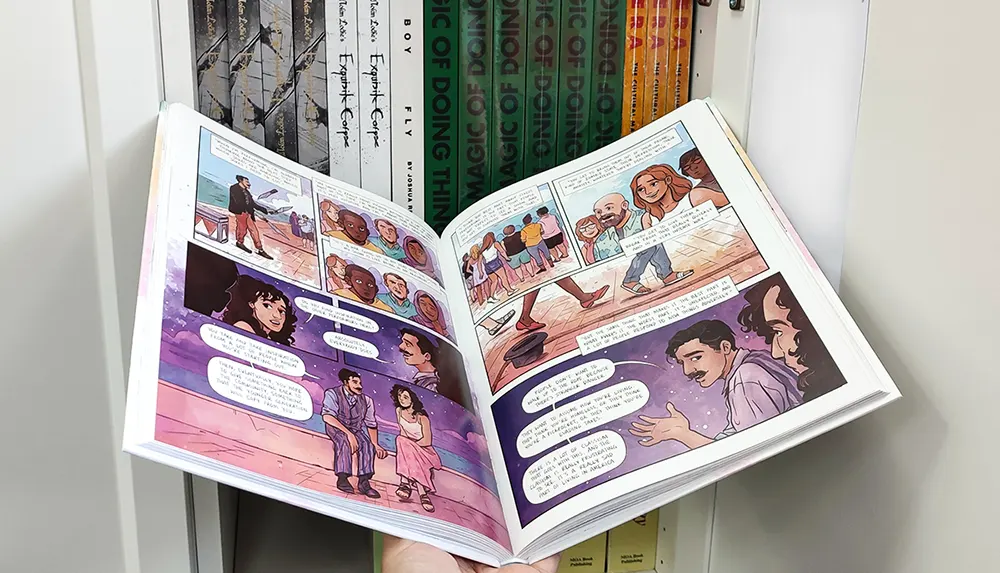Hardcover Books for Young Adults and Teen Readers
Hardcover Books for Young Adults and Teen Readers
Blog Article
A Comprehensive Overview to the Process of Hardbound Books Printing
When you start the journey of hardcover book printing, comprehending the whole procedure is crucial. As you navigate through binding and top quality control, you'll discover that every decision impacts the book's overall appeal.
Comprehending the Hardbound Book Structure
When you discover the globe of hardcover books, you'll rapidly discover that their structure is deliberate and unique. You'll locate a textile or natural leather covering, which not just boosts aesthetics but also adds to the publication's durability.
The text block itself includes multiple trademarks, or folded sheets, stitched with each other for stamina. You'll see that the spine is enhanced, permitting a smooth lay-flat analysis experience - hardcover books. Furthermore, the book's weight often conveys a sense of quality and permanence
Hardcover publications usually include a dust jacket, which acts as an advertising tool while safeguarding the cover. Recognizing these components aids you value the craftsmanship behind hardcover publications and their one-of-a-kind charm in the literary world.
Manuscript Prep Work and Editing And Enhancing
Getting your manuscript prepared for printing is necessary, and it starts with proper format guidelines. You'll require to understand the modifying procedure to fine-tune your work and guarantee it reverberates with readers. Plus, understanding proofreading strategies can help you catch those annoying errors before your book goes to publish.

Manuscript Format Guidelines
Correct manuscript formatting is important for producing a professional-looking hardcover book. Begin by choosing a common font like Times New Roman or Arial in 12-point size. Usage double-spacing throughout the record to improve readability. Establish your margins to 1 inch on all sides, giving your message area to breathe. Number your pages in the top right corner, and include your chapter titles at the start of each new section. Use clear headings to show sections, and avoid excessive formatting like bold or italics unless necessary. Make sure to check your manuscript for consistency stylishly, guaranteeing that every little thing from spelling to spacing complies with your selected guidelines. Complying with these steps will establish a solid structure for your book.
Modifying Process Essentials
Editing your manuscript is a vital step that can change it from an outline into a polished end product. Beginning by reviewing your job seriously, concentrating on quality, structure, and flow. Try to find inconsistencies in your narrative, character development, or argumentation. It's helpful to take breaks between rounds of modifying to acquire fresh perspectives. Do not wait to cut unnecessary web content or rephrase uncomfortable sentences; this will enhance readability. Think about looking for responses from relied on peers or specialist editors that can offer important insights. Bear in mind, modifying isn't nearly dealing with errors; it's about refining your voice and ensuring your message reverberates with visitors. Welcome the procedure, and you'll see your manuscript sparkle.
Checking Techniques Introduction
As soon as you have actually brightened your manuscript via editing and enhancing, the next action is to ensure it's complimentary of errors that could distract visitors. Read your manuscript aloud-- this helps you listen to unpleasant phrasing and place typos. Take into consideration printing your manuscript; reading on paper can expose errors that displays miss.
Creating guide Cover and Inside
When you're designing your publication cover and interior, you'll want to concentrate on crucial layout aspects that capture your audience's focus. Choosing the appropriate typography designs and carefully choosing colors and imagery can make all the difference in communicating your book's style. Let's check out exactly how these options can raise your work and bring in viewers.
Necessary Layout Elements
Creating a distinctive book cover and a well-designed inside is important for attracting viewers and improving their experience. Choose shades and images that reflect your book's theme and state of mind.
For the inside, concentrate on layout and white room. A clean, orderly style helps readers browse easily. Think about using phase headings and subheadings to guide them with the material. Visual elements, like graphics or illustrations, can likewise enhance engagement however must complement the message, not bewilder it. Remember, a cohesive layout throughout your publication fosters an expert look that can considerably affect a visitor's choice to choose it up.
Choosing Typography Styles
Typography plays an important duty in both the book cover and indoor style, forming how readers regard your web content. When picking typography styles, consider your book's category and target market. A traditional serif font style might work well for literary fiction, while a modern sans-serif might suit a modern story. Guarantee readability; your message needs to be easy on the eyes, particularly for longer flows. Pay interest to font size and line spacing, as these aspects influence total circulation. Blending typefaces can add rate of interest, but restrict it to 2 or three to keep coherence. Assume concerning pecking order-- utilize various styles for headings and body message to guide visitors easily with your job. Your typography options will greatly impact the reader's experience.
Color and Images Choice
Choosing the web right shades and imagery is vital for catching visitors' interest and sharing your publication's themes. Begin by considering your style; lively colors could function for a kids's book, while low-key tones suit a mystery novel. hardcover books. Use images that resonates with your web content-- images, pictures, or abstract styles can enhance your message
When designing the cover, make particular the images does not bewilder the title and author's name; clarity is essential. This natural technique not just boosts your book's aesthetic yet likewise improves the visitor's experience, making it much more memorable.
Choosing the Right Paper and Products
When selecting paper and products for your hardcover book, it's important to ponder just how they'll influence the total feel and look of your project. Beginning by choosing the ideal paper weight; much heavier supply typically shares high quality and toughness, while lighter paper can develop an extra delicate touch. Consider the coating as well; glossy paper improves colors and photos, while matte can offer an innovative, underrated appearance.
Towel, leather, or published paper can establish the tone for your publication. In addition, think about the binding materials; using top notch sticky guarantees your publication lasts.
Ultimately, the options you make below reflect your vision, so make the effort to sample different materials (hardcover books). Your options will certainly assist develop a book that's not just visually attractive however also resilient and practical
The Printing Refine: Methods and Technologies
A range of printing techniques and modern technologies can bring your hardbound book to life, each offering one-of-a-kind benefits. Digital printing is a prominent option for short runs, permitting for quick turnaround and cost-effective services.
For unique results, you could think about techniques like foil marking or embossing, which can include an extravagant touch to your cover. Additionally, you can select numerous inks, including environment-friendly options that cater to eco aware readers. Comprehending these techniques aids you make informed decisions, ensuring your hardcover book not just looks terrific however additionally fulfills your production needs properly. Pick the ideal strategy to raise your publication's appeal and effect.
Binding Methods for Hardbound Books
Numerous binding techniques can transform your hardcover publication into a eye-catching and durable item. An additional technique is the perfect binding, which utilizes adhesive to hold the pages with each other, permitting for a streamlined spinal column but much less sturdiness contrasted to case binding.
You could also consider spiral binding, which enables your book to lay flat, making it perfect for guidebooks or workbooks. It does not from this source supply the exact same safety cover as case binding. Lastly, there's the saddle stitch approach, suitable for smaller publications, where sheets are folded and stapled with each other. Each binding method has its benefits and fits various demands, so think of your publication's objective and target market when choosing the very best alternative for your job.
High Quality Control and Final Touches
After picking the right binding technique for your hardcover book, quality assurance becomes important to confirm your end product satisfies your expectations. Beginning by examining the printed pages for any mistakes or incongruities in shade and design. You don't want to miss out on any type of typos or misprints that could affect your viewers' experience.
Following, check the binding integrity. Validate the pages are securely affixed which the spinal column is durable. A well-bound book not just looks expert but additionally feels durable in your hands.
In addition, focus on the cover. Try to find any type of scuff marks or misalignments in the art work. Make sure they're used regularly throughout all copies. if you have actually chosen for unique surfaces like embossing or foil marking.
Finally, perform a detailed assessment of the entire set before relocating to circulation. In this manner, you can validate that every book mirrors your high standards.
Regularly Asked Questions
Exactly how Lengthy Does the Hardcover Publication Printing Process Normally Take?

What Is the Minimum Order Amount for Hardcover Books?
The minimum order quantity for hardbound publications generally begin around 100 duplicates, however it can differ based upon the printer. You should contact your picked printing service for their particular needs and rates.

Can I Print Hardbound Books in Personalized Sizes?
Yes, you can print hardcover publications in custom sizes. Numerous printing services provide versatility with dimensions, enabling you to select a style that suits your project. Just confirm the specifications prior to positioning your order.
Exist Eco-Friendly Options for Hardcover Book Printing?
Yes, you can locate green choices for hardbound publication printing. Numerous companies use recycled products and lasting inks. Just ask your printer concerning their green techniques to ensure your project straightens with your environmental worths.
What Are the Expenses Associated With Hardbound Book Printing?
When taking into consideration hardcover publication printing expenses, you'll require to variable in materials, design, and printing approaches. Added costs like shipping and binding can additionally affect your overall spending plan, so strategy appropriately for your project.
When you start the journey of hardbound publication printing, understanding the whole procedure is vital.A variety of printing strategies and innovations can bring your hardcover publication to life, each offering distinct benefits. Exactly how Long Does the Hardbound Book Printing Refine Usually Take?
The hardbound book printing procedure usually takes about 2 to 6 weeks.Yes, you can discover eco-friendly choices for hardbound publication printing.
Report this page